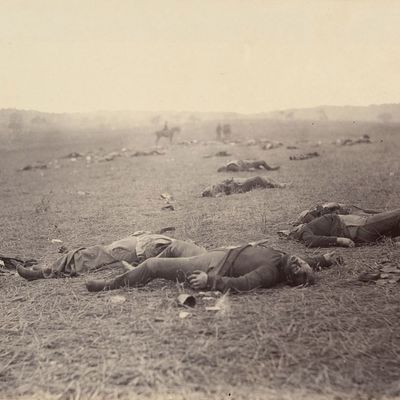
Slavery is Americas permanent Agony in the Garden of Gethsemane, in which our country carries a cup it can never pass. The closest that white America has ever come to experiencing what James Baldwin described as the Negros past, of rope, fire, torture, castration, infanticide, rape  fear by day and night, fear as deep as the marrow of the bone was in 1861, when the country tore itself in half over race and money. The Metropolitan Museum of Arts incredibly affecting Photography and the American Civil War is a shocking view of a pain so deep, destruction in blood and psyche, that seeing these 200 or so photographs installed in eleven galleries amounts to a silent scream. Viewers walk through this showits galleries painted charcoal, its walls covered in canvasin hushed silences, reverent, shaken, respectful of the ineffable suffering and almost mystical sickness depicted. D.H. Lawrences words come to mind: Doom! Doom! Doom! Something seems to whisper it in the very dark tress of America. Doom! I do not remember experiencing a more poignant and pathos-filled photography exhibition at any museum.
The catalogue looks cheesy, like a gift book, but in its prologue, the excellent curator Jeff L. Rosenheim writes that this is ÔÇ£not a history of the Civil War, but rather an exploration of the role of the camera at a watershed moment in American culture.ÔÇØ This is true and not true. It is astonishing to think about the medium of photography, barely twenty years old, thrown into this cauldron of death and historyÔÇöapproximately 1,000 photographers producing hundreds of thousands of albumen silver prints, collodion-on-glass-plate negatives, daguerreotypes, cased ambrotypes, tintypes, cartes-de-visite, and stereographic scenes, some of them the most memorable pictures ever made. Still, thereÔÇÖs no way to separate photographyÔÇÖs history from history itself. Most viewers will look past the formalist notion of a medium rising to the occasion and will instead behold horror, pain, and endless sadness. This is as it should be.
The show begins with a startling 1860 William Marsh portrait of Abraham Lincoln. He becomes an instant stand-in for the unspeakable distortion the country was about to enter. It is jolting to see how young he looks, but heÔÇÖs not innocent. He is already gaunt, as if he knows what is to come. The only bone I have to pick with this show is that it would have been useful to see one of the last pictures taken of Lincoln in order to see how the war devastated his face in only four years, aged him, drained him of life, and made him a cursed ghost.
The place names depicted read like haunted poetry. Bull Run, Fredericksburg, Gettysburg, Harpers Ferry, Fort Sumter, Appomattox. At the Met we see images of slaves and slavers, whipped runaway slaves, branded slaves with metal cages on their heads, pens where slaves were held for sale. There are torn-up tracks, blown-up bridges, troops marching, cannon and cannonballs, boy soldiers, 33,000 Union prisoners in the Confederate stockade prison of Andersonville, an emaciated prisoner who looks like the living dead we see in Holocaust pictures, piles of amputated body parts, dead horses, assassins, abolitionists, an empty-eyed woman holding pictures of young soldiers, the war-destroyed cities of Richmond and Atlanta.
Cameras couldnÔÇÖt yet capture the fast action of war, so photographers depicted scenes in the wake of battle. We see the aftermath of the 1862 battlefield at Antietam, the single bloodiest day in American history, when more than 26,000 Confederate and Union soldiers were killed or wounded or captured, or went missing. A country doesnÔÇÖt recover from this. The next year, in Timothy H. OÔÇÖSullivanÔÇÖs A Harvest of Death, Gettysburg, we see bloated corpses, their mouths agape. Also from Gettysburg is Alexander GardnerÔÇÖs Home of a Rebel Sharpshooter, a picture of a dead man in a trench with his rifle standing nearby. Many protest that the rifle was set up and thus demeans the picture. It doesnÔÇÖt matter; the scene sunders souls either way. From the last year of the war is John ReekieÔÇÖs A Burial Party, Cold Harbor, Virginia, a stretcher full of skulls, a severed foot, and black men doing the ghoulish work of hauling the dead from a ravaged field for proper burial. By the showÔÇÖs final gallery, with its images devoted to LincolnÔÇÖs assassination, even GardnerÔÇÖs tragic Execution of the Conspirators becomes just another soul-shattering picture. As it should be. This is what Baldwin meant when he wrote, ÔÇ£Time catches up with kingdoms and crushes them.ÔÇØ
Photography and the American Civil War. The Metropolitan Museum of Art. Through September 2.
*This article originally appeared in the May 6, 2013 issue of New York Magazine.

